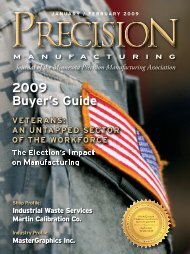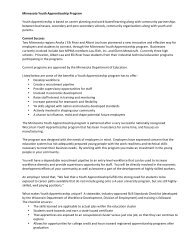July / August - Minnesota Precision Manufacturing Association
July / August - Minnesota Precision Manufacturing Association
July / August - Minnesota Precision Manufacturing Association
You also want an ePaper? Increase the reach of your titles
YUMPU automatically turns print PDFs into web optimized ePapers that Google loves.
Before engaging, however, it’s important to understand<br />
and respect the unwritten rules of each social media avenue.<br />
Consider two real world examples from two well-known<br />
brands – one great, the other a great example of what not to do.<br />
SOCIAL MEDIA SUCCESS<br />
<br />
Doritos created its “Crash the Super Bowl” campaign in 2007.<br />
This consumer-generated contest gave average people a chance to<br />
produce their very own Doritos commercial, upload it to the Web<br />
and have a shot at the grand prize: having their video aired live<br />
during the Super Bowl.<br />
But the winning video wasn’t decided by Doritos. Instead, the<br />
general public voted via a customized Web site created specifically<br />
for the contest, which also allowed users to comment and share<br />
their opinions on the contestants. This contest contained all the<br />
ingredients for a successful social media campaign – it engaged<br />
consumers by giving them an interesting subject for discussion,<br />
it provided a convenient platform for the conversation and it<br />
generated a lot of buzz for the Doritos brand in the process.<br />
SOCIAL MEDIA BLUNDER<br />
<br />
On the flip side, Wal-Mart found a way to display the<br />
deceiving and downright ugly side of social media. In September<br />
2006, a blog entitled, “Walmarting Across America,” was born.<br />
The premise was based on an everyday American couple, Jim and<br />
Laura, documenting their RV journey from Las Vegas to Georgia<br />
via a blog – camping out in Wal-Mart parking lots along the way.<br />
During their travels, the couple interviewed Wal-Mart<br />
employees, all of whom expressed extreme enthusiasm about<br />
working for the mega-retailer. Such widespread sentiment<br />
raised a small but very red flag in the minds of media watchers.<br />
Shortly after Jim and Laura’s journey began, they were<br />
uncovered as fakes.<br />
Jim and Laura’s blog was actually a “flog” (fake blog).<br />
It turned out that Wal-Mart’s PR firm not only created the flog,<br />
but also developed the content published by “Jim,” (actually a<br />
staff photographer for The Washington Post) and “Laura,”<br />
(a real-life freelance writer), both of whom had been hired<br />
for the campaign.<br />
The differences between these two examples are many, but<br />
transparency is probably the most outstanding. Doritos created<br />
a campaign that was open and straightforward.<br />
Wal-Mart did not. Consumers are smart, certainly a lot<br />
smarter than most executives assume. As legendary advertising<br />
man David Ogilvy once said, “The consumer isn’t a moron;<br />
she is your wife.”<br />
Besides respecting the rules of engagement for social media,<br />
it’s also important to ask yourself what you expect to gain and<br />
what avenue best fits your goal. Not all social media channels<br />
make sense for all brands.<br />
For example, a company selling life insurance and retirement<br />
plans may not be the best candidate for a viral video, mainly<br />
because the content isn’t all that entertaining (a requisite for most<br />
successful viral videos). However, that same company might<br />
consider, for example, a branded Web site that provides a forum<br />
where future retirees can interact and share stories about their<br />
retirement plans, possibly with a promotional or contest element.<br />
As technology and the speed of Internet information continue<br />
to advance, social media will play an increasingly important<br />
role in the way companies communicate with customers.<br />
Online is going mainstream, so now is the time to get in on the<br />
conversation. Assess your goals, find ways to leverage social<br />
media opportunities and take an open, honest approach to gain<br />
a competitive advantage. PM<br />
Jason Swartz is a web marketer and copywriter for Padilla Speer<br />
Beardsley, a multi-specialty communications consulting firm with<br />
headquarters in Minneapolis and an office in New York.<br />
Jason majored in creative advertising at Drake University in<br />
Des Moines, Iowa and earned a bachelor’s degree from the school of<br />
Journalism and Mass Communication.

















